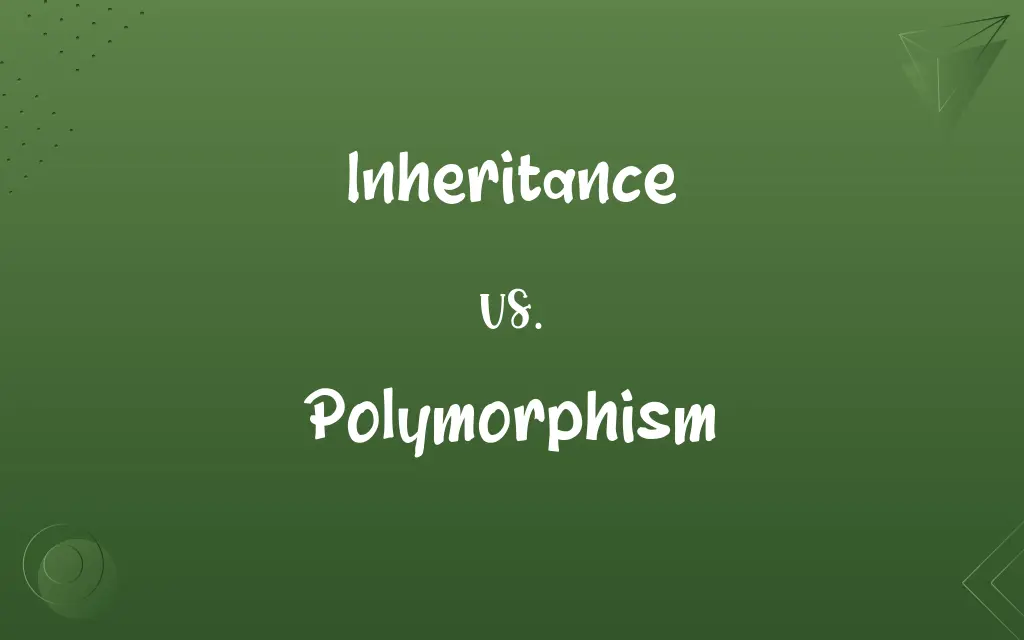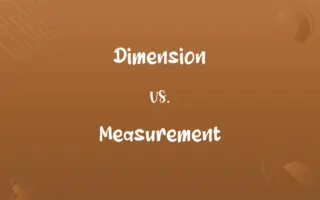Inheritance vs. Polymorphism: Know the Difference

By Shumaila Saeed & Dua Fatima || Published on November 21, 2024
Inheritance enables a class to derive properties from another, while polymorphism allows objects to be treated as instances of their parent class or interface.

Key Differences
Inheritance is a fundamental OOP concept where a class (child) derives attributes and behaviors from another class (parent), establishing a hierarchical relationship. Polymorphism, on the other hand, refers to the ability of objects to take on many forms, allowing a child class object to be treated as an instance of the parent class, facilitating code flexibility and reuse.
Dua Fatima
Nov 21, 2024
Through inheritance, child classes inherit methods and fields from the parent class, reducing code redundancy. Polymorphism, particularly through method overriding and interfaces, enables objects to execute different methods depending on their type, even when accessed through a reference of a common superclass or interface.
Shumaila Saeed
Nov 21, 2024
Inheritance is static, established at compile-time, creating a fixed class hierarchy. Polymorphism is more dynamic, often realized at runtime, especially with method overriding, allowing objects to invoke overridden methods of child classes through parent class references.
Shumaila Saeed
Nov 21, 2024
The use of inheritance structures the code and defines a clear relationship between classes, which can lead to issues like tight coupling and hierarchy rigidity. Polymorphism, by enabling interchangeable object usage, promotes loose coupling and enhances modularity, making the system more maintainable and scalable.
Shumaila Saeed
Nov 21, 2024
Inheritance focuses on the "is-a" relationship, implying that the child class is a type of the parent class, polymorphism leverages this relationship to use child class objects in place of parent class objects, adhering to the "can be treated as" principle, thereby supporting diverse object interactions.
Dua Fatima
Nov 21, 2024
ADVERTISEMENT
Comparison Chart
Definition
A mechanism for a class to derive properties and behavior from another class
The ability of objects to take on many forms
Dua Fatima
Nov 21, 2024
Key Principle
"Is-a" relationship, indicating type hierarchy
"Can be treated as", enabling flexible object interaction
Dua Fatima
Nov 21, 2024
Implementation
Static, defined at compile-time
Dynamic, often realized at runtime
Shumaila Saeed
Nov 21, 2024
Usage
Establishes class hierarchies, inheriting attributes and methods
Enables objects to execute different method implementations
Shumaila Saeed
Nov 21, 2024
Benefits
Reduces code redundancy, establishes relationships
Increases flexibility, promotes code reuse
Shumaila Saeed
Nov 21, 2024
ADVERTISEMENT
Inheritance and Polymorphism Definitions
Inheritance
A child class inherits properties from a parent class.
A Dog class inherits from an Animal class.
Dua Fatima
Feb 26, 2024
Polymorphism
Facilitates interface-based polymorphism.
Implementing an IWalkable interface by different animal classes.
Shumaila Saeed
Feb 26, 2024
Inheritance
Forms a hierarchical class structure.
Animal as a base class for Dog, Cat, etc.
Shumaila Saeed
Feb 26, 2024
Polymorphism
Adheres to the "can be treated as" principle.
A Dog object can be treated as an Animal.
Dua Fatima
Feb 26, 2024
ADVERTISEMENT
Polymorphism
Supports method overriding for runtime behavior.
Dog overrides Animal's makeSound method.
Shumaila Saeed
Feb 26, 2024
Inheritance
Enables code reuse by inheriting methods and fields.
Dog uses the eat method inherited from Animal.
Shumaila Saeed
Feb 26, 2024
Polymorphism
Enhances code flexibility and reuse.
A single feed method can accept any Animal type.
Dua Fatima
Feb 26, 2024
Inheritance
Can lead to tight coupling between classes.
Changes in Animal might affect Dog.
Hifza Nasir
Feb 26, 2024
Polymorphism
Allows objects to be treated as instances of their parent class.
An Animal reference can point to a Dog object.
Dua Fatima
Feb 26, 2024
Repeatedly Asked Queries
Can you give an example of polymorphism?
A common example is overriding a base class method in a derived class, allowing for different implementations when accessed through a base class reference.
Shumaila Saeed
Nov 21, 2024
Why is inheritance important?
Inheritance promotes code reuse and establishes clear relationships between classes, aiding in organizing complex systems.
Shumaila Saeed
Nov 21, 2024
What is inheritance in OOP?
Inheritance allows a class to derive properties and behaviors from another class, forming a hierarchy.
Dua Fatima
Nov 21, 2024
What are the downsides of extensive inheritance?
Overuse of inheritance can lead to tight coupling and hierarchy complexity, making the system rigid and harder to maintain.
Hifza Nasir
Nov 21, 2024
What role do interfaces play in polymorphism?
Interfaces define contracts that multiple classes can implement, promoting polymorphism without the constraints of inheritance.
Dua Fatima
Nov 21, 2024
How can polymorphism reduce code redundancy?
By allowing a single function to interact with objects of different classes, polymorphism reduces the need for similar code for each class.
Shumaila Saeed
Nov 21, 2024
Can inheritance lead to problems in software design?
Yes, improper use of inheritance can lead to fragile designs, where changes in the parent class might unexpectedly affect derived classes.
Hifza Nasir
Nov 21, 2024
How does polymorphism work in OOP?
Polymorphism enables objects to be treated as instances of their parent class, allowing for flexible method invocation.
Shumaila Saeed
Nov 21, 2024
What is the "Liskov Substitution Principle" in relation to inheritance?
It states that objects of a superclass should be replaceable with objects of subclasses without affecting the correctness of the program.
Shumaila Saeed
Nov 21, 2024
Is multiple inheritance supported in all OOP languages?
Not all languages support multiple inheritance directly due to complexity and ambiguity issues; some use interfaces or traits instead.
Shumaila Saeed
Nov 21, 2024
What is method overloading and how does it relate to polymorphism?
Method overloading allows multiple methods in the same class with the same name but different parameters, increasing polymorphism within a class.
Dua Fatima
Nov 21, 2024
How does polymorphism enhance software design?
Polymorphism increases flexibility and modularity by enabling interchangeable use of objects, facilitating easier maintenance and extension.
Shumaila Saeed
Nov 21, 2024
How does polymorphism differ from inheritance?
Polymorphism is about how object instances are treated, allowing for multiple forms, while inheritance is about forming class hierarchies and sharing properties.
Hifza Nasir
Nov 21, 2024
How does dynamic polymorphism differ from static polymorphism?
Dynamic polymorphism (method overriding) is resolved at runtime, while static polymorphism (method overloading) is resolved at compile-time.
Dua Fatima
Nov 21, 2024
Can polymorphism exist without inheritance?
Yes, through interfaces and duck typing in dynamic languages, polymorphism can be achieved without traditional inheritance.
Shumaila Saeed
Nov 21, 2024
Share this page
Link for your blog / website
HTML
Link to share via messenger
About Author
Written by
Shumaila SaeedShumaila Saeed, an expert content creator with 6 years of experience, specializes in distilling complex topics into easily digestible comparisons, shining a light on the nuances that both inform and educate readers with clarity and accuracy.
Co-written by
Dua Fatima








































































